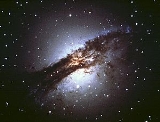
SN 1986G
Encyclopedia
SN 1986G was a supernova
that was observed on May 3, 1986 by Robert Evans
. Its host galaxy
was Centaurus A
about 15 million
light-year
s away in the constellation
Centaurus
. Since Centaurus A is about 15 million light-years away from us, this supernova happened 15 million years ago.
SN 1986G was a bright blue-green star
in the middle of the left part of the dust belt of Centaurus A. The blue-green color occurs because David Malin could take the red plate used in this composit image only one year after the supernova occurred, and it had faded away at that time.
Supernova
A supernova is a stellar explosion that is more energetic than a nova. It is pronounced with the plural supernovae or supernovas. Supernovae are extremely luminous and cause a burst of radiation that often briefly outshines an entire galaxy, before fading from view over several weeks or months...
that was observed on May 3, 1986 by Robert Evans
Robert Evans (astronomer)
Robert Owen Evans is a minister of the Uniting Church in Australia and an amateur astronomer who holds the all-time record for visual discoveries of supernovae ....
. Its host galaxy
Galaxy
A galaxy is a massive, gravitationally bound system that consists of stars and stellar remnants, an interstellar medium of gas and dust, and an important but poorly understood component tentatively dubbed dark matter. The word galaxy is derived from the Greek galaxias , literally "milky", a...
was Centaurus A
Centaurus A
Centaurus A is a prominent galaxy in the constellation of Centaurus. There is considerable debate in the literature regarding the galaxy's fundamental properties such as its Hubble type and distance...
about 15 million
1 E22 m
To help compare different orders of magnitude, this page lists distances starting at 10 Zm .Distances shorter than 10 Zm* 24 Zm — 2.5 million light years — Distance to the Andromeda Galaxy...
light-year
Light-year
A light-year, also light year or lightyear is a unit of length, equal to just under 10 trillion kilometres...
s away in the constellation
Constellation
In modern astronomy, a constellation is an internationally defined area of the celestial sphere. These areas are grouped around asterisms, patterns formed by prominent stars within apparent proximity to one another on Earth's night sky....
Centaurus
Centaurus
Centaurus is a bright constellation in the southern sky. One of the largest constellations, Centaurus was included among the 48 constellations listed by the 2nd century astronomer Ptolemy, and it remains one of the 88 modern constellations.-Stars:...
. Since Centaurus A is about 15 million light-years away from us, this supernova happened 15 million years ago.
SN 1986G was a bright blue-green star
Star
A star is a massive, luminous sphere of plasma held together by gravity. At the end of its lifetime, a star can also contain a proportion of degenerate matter. The nearest star to Earth is the Sun, which is the source of most of the energy on Earth...
in the middle of the left part of the dust belt of Centaurus A. The blue-green color occurs because David Malin could take the red plate used in this composit image only one year after the supernova occurred, and it had faded away at that time.
External links
- Radio Observations of the Type Ia SN 1986G and Constraints on the Symbiotic-Star Progenitor Scenario

